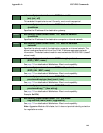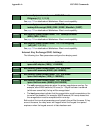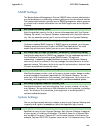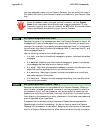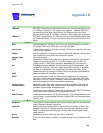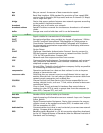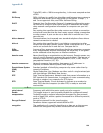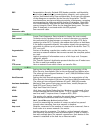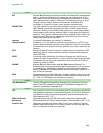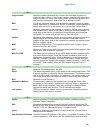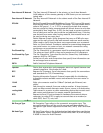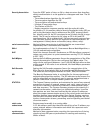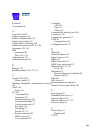
151
Appendix B
ESP Encapsulation Security Payload (ESP) header provides confidentiality,
data origin authentication, connectionless integrity, anti-replay pro-
tection, and limited traffic flow confidentiality. It encrypts the contents
of the datagram as specified by the Security Association. The ESP
transformations encrypt and decrypt portions of datagrams, wrapping
or unwrapping the datagram within another IP datagram. Optionally,
ESP transformations may perform data integrity validation and com-
pute an Integrity Check Value for the datagram being sent. The com-
plete IP datagram is enclosed within the ESP payload.
Ethernet
crossover cable
See crossover cable.
-----F-----
FCS Frame Check Sequence. Data included in frames for error control.
flow control Technique using hardware circuits or control characters to regulate
the transmission of data between a computer (or other DTE) and a
modem (or other DCE). Typically, the modem has buffers to hold data;
if the buffers approach capacity, the modem signals the computer to
stop while it catches up on processing the data in the buffer. See CTS,
RTS, xon/xoff.
fragmentation Process of breaking a packet into smaller units so that they can be
sent over a network medium that cannot transmit the complete packet
as a unit.
frame Logical grouping of information sent as a link-layer unit. Compare
datagram, packet.
FTP File Transfer Protocol. Application protocol that lets one IP node trans-
fer files to and from another node.
FTP server Host on network from which clients can transfer files.
-----H-----
Hard MBytes Setting the Hard MBytes parameter forces the renegotiation of the
IPSec Security Associations (SAs) at the configured Hard MByte value.
The value can be configured between 1 and 1,000,000 MB and refers
to data traffic passed.
Hard Seconds Setting the Hard Seconds parameter forces the renegotiation of the
IPSec Security Associations (SAs) at the configured Hard Seconds value.
The value can be configured between 60 and 1,000,000 seconds
hardware handshake Method of flow control using two control lines, usually Request to
Send (RTS) and Clear to Send (CTS).
HDLC High-level Data Link Control.
HDSL High-data-rate Digital Subscribe Line. Modems on either end of one
or more twisted pair wires that deliver T1 or E1 speeds. T1 requires
two lines and E1 requires three. Compare ADSL, SDSL.
header The portion of a packet, preceding the actual data, containing source
and destination addresses and error-checking fields.
HMAC Hash-based Message Authentication Code
hop A unit for measuring the number of routers a packet has passed
through when traveling from one network to another.
hop count Distance, measured in the number of routers to be traversed, from a
local router to a remote network. See metric.
hub Another name for a repeater. The hub is a critical network element
that connects everything to one centralized point. A hub is simply a
box with multiple ports for network connections. Each device on the
network is attached to the hub via an Ethernet cable.



